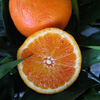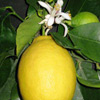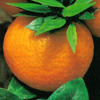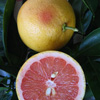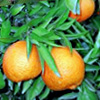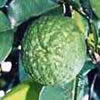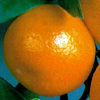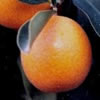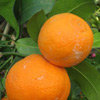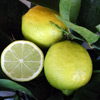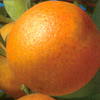
![]() Citruses
Citruses
Citruses are very susceptible to
low
temperatures but they don’t need very
high temperatures to ripen fruits
Citrus, symbol of Mediterranean warmth and sun, have Asian origins and precisely of the Middle East. They were imported to Sicily by the Arabs in the IX-XI century A.C., but only in the XVII century began the intensive cultivation of citrus by the Jesuits. To date, Sicily produces 54% of Italian citruses. CHARACTERISTICS OF CITRUSESCharacterized by a woody structure and evergreen leaves which give the foliage a compact and globular shape, citruses are distinguished by the extremely fragrant white flowers and by the peculiar fruits consisting of an outer part (the peel), rich in pigments and very fragrant essential oils, which appears initially green but takes color in relation to the stage of maturation and the species, and of an internal part (the pulp), usually rough and juicy, rich in vitamin C, which is mainly used for diets. Citruses are very susceptible to low temperatures (that’s the reason why they are distributed along the coastal areas), but they don’t need very high temperatures to ripen fruits. Among the main citruses grown for ornamental purposes there are: oranges, mandarins, grapefruits, lemons, limes, calamondinos, kumquat See our citruses in bloom › |
|||||||||||||||||||||||||||||||||||||||
Citrus Sinensis - Orange see our product › |
| Description: They are divided into two types: seet orange and bitter orange. The sweet orange or Citrus Sinensis is the most cultivated in the world for the consumption of fresh fruits, very rich in vitamin C. Beautiful and very fragrant, the orange flower, called “zagara”, is recently used in floreal arrangements. |
Citrus Limon – Lemon see or product ›
| Description: Lemon is certainly one of the most appreciated citrus fruit par excellence. It is a tree of average growth. This plant is usually cultivated for fruit production, but for about some decades now it is also very required for ornamental purposes. |
Citrus Myrtifolia - Chinotto see our product ›
| Description: Plant with very compact branches, and with leaves which are similar to the myrtle. It produces many fruits, and this characteristic makes the plant very good-looking. The little fruits remain on the plant for a long time (even 2 years). They are bitter, but are used for syrups, beverages, and of course the homonymous drink: Chinotto. It is the only citrus fruit with no thorns. |
Citrus Paradisi - Grapefruit see our product ›
| Description: Known for the grandeur of its fruit, for the very fine juice, the grapefruit is one of the most pleasant citruses. The plant is of medium vigor, with dark green and shiny leaves. Fruiting depends on the age of the plant itself (about 4 years), but when the time comes it surely becomes a wonderful scenario, to see a grapefruit plant with its fruits. Prticularly attractive is the pink grapefruit, hybrid with orange, that has atrracted special attention for its edibility. |
Citrus clementina – Clementine see our product ›
| Description: The plant of the clementine is very similar to that of the mandarin, also in the foliage. The leaves are slightly larger, however, they are lanceolate. This citrus has a slow fruiting, because of the sudden changes in temperature, the fruit is round, of a beautiful bright orange, very appreciated for its edibility. Its flavor is similar to that of the orange. |
Citrus clementine – Ruby red see our product ›
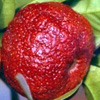 |
Description: The plant shows a beautiful foliage and its poise is the same as any variety of clementine. It is in bloom once a year and as fruiting occurs the fruit becomes bright red, and this color is so intensive that it is called “ruby”. The result is very beautiful to see. Thanks to that it is considered as a citrus for collectors. |
Citrus hystrix- Papeda of Mauritius see our product ›
| Description: Called Papeda of Mauritius or even Combava, it is a plant that comes from India, where is grown mainly. The detail that identifies it from other citrus is that, besides the edible fruits, it has edible leaves. They are both used in cooking, for cocktails, beacause of their special fragrance. |
Citrus Limon “red”– Red limon see our product #
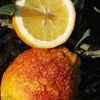 |
Description: This plant has a high ornamental value for its characteristic red peel, once the fruit matured. The poise of this plant is similar to any other lemon, but its fruiting is less generous. |
Citrus mitis – Calamondino see our product ›
| Description: This plant is very vigorous, productive and fairly resistant to cold. Among the many varieties of citrus, is one of the most used for ornamental purpose. The long persistence of the fruit on the tree, creates a true decoration especially during Christmas time, because this fruit bears very well the dry climate of apartments. |
Citrus reticulata - Mandarin see our product ›
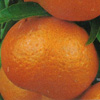 |
Description: Mandarin is a average-growth plant. It has a rather dense and harvest foliage. The characteristic scent both of the leaves and the fruits, comes from the essential oils in the plant itself. The fruits mature in December and they are very palatable for their sweet pulp. |
Fortunella Japonica – Round kumquat see our product ›
| Description: Widespread citrus for interior and exterior embellishment. Small-sized plant, and very rustic. Its fruits are golden-yellow, with bitter and slightly vanilla flavor, they are eaten whole. |
Fortunella margarita – Oval kumquat see our product ›
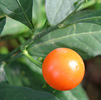 |
Description: It surely comes from China, and it has very ancient origins. Its foliage is quite compact, the branches have few thorns. The little oval fruits are orange and very required for their edibility. |
Citrus Limonia- Lime of Rangpur see our product ›
| Description: This citrus variety is surely a hybrid. It has a dark green foliage, and it shows an almost purple blossom. It fructifies very much and for that ir requiredfor decorations, preparations, and as ornamental citrus. The fruit is round and slightly oblate and when maturation is complete it takes on a beautiful red/orange. It’s resistant to cold. |
Citrus Limetta Pursha- Sweet Roman lime see or product ›
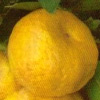 |
Description: This citrus is known for its blooming, for that it fructifies a lot. It has a quite brushy foliage. The yellow fruits attract for their characteristic wrinkled peel and create a pleasant fall of color. They are edible and persist for a long time on the plant, which becomes particularly ornamental. |
Citrus latifolia – Lime of Tahiti see our product ›
| Description: This citrus is very ornamental and of average sizes. Under favorable condition it blooms and fructifies several times a year. Recently, the fruit is substituted for the lemon, for its smaller size. The juice is less sour than that of the lemon, it is palatable, and also used for cocktails. |
Citrus Limettoides - Sweet lime of Palestina see our product ›
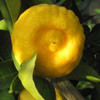 |
Description: Also called Lime of the Patriarch, it is probably one of the most ancient and precious citrus. It is very popular in India and in Middle East. The plant has a relatively slow and good fruiting. The particularities of this citrus are different: the fruits contain rare seeds , they are very fragrant and the pulp is essentially free of acidity, for that called “sweet”. |
Fortunella obovata see our product ›
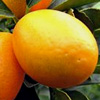 |
Description: Its foliage is very compact too. The difference essentially lies in larger leaves and bigger fruits, very required in cooking. They are edible raw and have a thirst-quenching effect. |
Kukla ( Fortunella margarita x Citrus reticolata) see our product ›
| It is a beautiful hybrid between clementine and oval kumquat. The very dense foliage and the dark green leaves, enhance the intense orange color of the fruit, similar to that of kumquat, but bigger. |
OTHER VARIETIES CULTIVATED IN OUR NURSERIES:
Citrus limon X Citrus paradisi – (Lipo); Citrus aurantifolia – (Lime La Vallette); Citrus medica var. sarcodactylis – (Buddha Hand).Preparatory phase before forwarding
Our citruses, before forwarding, are washed to remove any dust and treatments which contain dyes that alter the color of the plant and of the fruit itself, giving them a truly ornamental appearance.
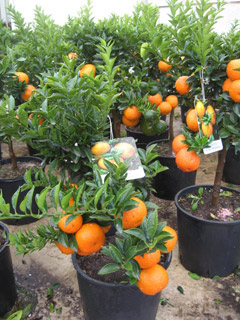 .| .| 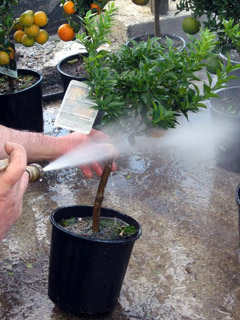 |. |. 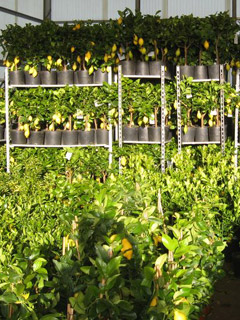 |
Offer of the month BUY NOW !! |
ORNAMENTAL CITRUSES GROWN IN OUR NURSERIES |
| Nurseries Cavallaro direct production and sale of different qualities of citrus, olive tree and palms, caper, strelizia ^ UP ^ via Statale Oreto 13 - 98051 Barcellona Pozzo di Gotto (ME) - Italy Tel. and Fax +39 090 8968872 Fax 090 8967219 VAT 02897660839 |
